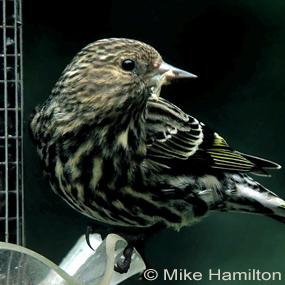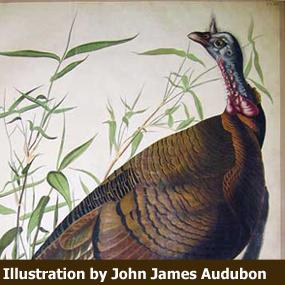For "Winged Wednesday":
Brown-headed Nuthatch, Tiny Tool-user of the Southeast Forests:


"Although tool use is rare among birds, the tiny, quick-moving Brown-headed Nuthatch is an exception: It can often be observed using a piece of bark to pry up loose bark in search of insects. The bird may carry this “tool” from tree to tree as it forages and even use it to cover up caches of seeds.
This nuthatch’s call is a series of high-pitched squeaky notes, sounding somewhat like a rubber-ducky bathtub toy. A flock of them can sound like bath time gone wild!
Nests of Brown-headed Nuthatches, usually excavated in snags, are regularly attended by extra birds, often young males that may be older offspring of the breeding pair. After breeding, these social nuthatches gather in groups of a dozen or more and move through the woods in mixed flocks with woodpeckers, chickadees, titmice, and Pine Warblers.
The species’ population is suffering the effects of logging and fragmentation in southeastern pine forests. Fire suppression may also negatively affect the Brown-headed Nuthatch by reducing the number of snags and enabling dense understory growth."
______
Why Conserve Birds?

"We are the Americas’ bird conservation specialists, founded in 1994 to protect native birds and their habitats throughout the Western Hemisphere. These truths about birds underlie our mission and underscore every aspect of our work:
Birds inspire us.
Our affection for birds dates to the dawn of our species. Eagles, doves, and ravens permeate our history, cultures, and religions. Images of cranes, falcons, geese, and parrots adorn the walls of Neolithic caves, Egyptian pyramids, Mayan temples—and most American homes today. Storks deliver us at birth and owls mourn our deaths. Each new generation marvels at the beauty of birds and their ability to fly away, leaving us simply to wonder.
Birds are indicators of environmental hazards.
Because they are sensitive to habitat change and are easy to census, birds are the ecologist's favorite tool. Changes in bird populations are often the first indication of environmental problems. Whether ecosystems are managed for agricultural production, wildlife, water, or tourism, success can be measured by the health of birds.
Protecting birds promotes good land stewardship.
Birds have been a driving force behind the American conservation movement since its early days, when unregulated hunting, use of toxic pesticides, and destruction of wetlands threatened our wildlife and wild places. The environmental problems we face today are even more complex, and we need a new generation of committed conservationists to counter them.
Birds are a tremendous economic resource.
Forty-six million Americans watch birds. Birders are the market for a burgeoning industry, spending hundreds of millions of dollars each year feeding birds, purchasing equipment, and traveling in pursuit of birds. This economic force—and the benefits birds provide in insect and rodent control, plant pollination, and seed dispersal—add value to sustaining birds and their habitats.
But most of all, we have a moral obligation.
As stewards of our planet, we have an absolute ethical obligation to maintain all other species regardless of their functional values. We should no more allow the loss of species than destroy a masterpiece of art. The very least our generation can do is to ensure our children inherit as much as we have now. It is on this ethical commitment to the future that American Bird Conservancy is founded." From: http://www.abcbirds.org/aboutabc/whybirds.html
_____
Scientists Struggle to Make Windows Safer for Birds

Fortunately, there are three avian research facilities in the country testing methods to prevent window crashes. But as it turns out, creating no-crash glass is more complicated than you might think. The first U.S. researcher to tackle the problem, ornithologist Daniel Klem Jr., has been working on solutions for 40 years. And while much has been learned about what birds can and can’t see, applying that knowledge to safer window designs – and getting those windows accepted for use by public and commercial interests – has proved difficult.
One problem, oddly enough, has been the growing popularity of “green” buildings. More natural light means more windows, which means more glass for birds to fly into. According to ornithologist Christine Sheppard of the Powdermill Avian Research Center in Rector, PA, tests show that opaque stripes or dots on windows can reduce bird collisions… if people are willing to use them.
Birds Didn’t Evolve to Recognize Glass as an Obstacle." More at: http://healthypets.mercola.com/sites/healthypets/archive/2013/11/22/bird-window-collisions.aspx
______
: Wind Energy Company to Pay $1 Million in Bird Deaths
"Duke Energy agreed on Friday to pay $1 million in fines as part of the Justice Department’s first criminal case against a wind power company for the deaths of protected birds.

Duke's $1 million in restitution and fines will be split as follows: $400,000 to the North American Wetlands Conservation Fund, $100,000 to the state of Wyoming, $160,000 to the National Fish and Wildlife Foundation, and $340,000 to a conservation fund for the purchase of land in Wyoming for golden eagle habitat." More at: http://www.nytimes.com/2013/11/23/us/wind-energy-company-to-pay-1-million-in-bird-deaths.html
______
Glaucus Atlanticus, real life pokemon

_______
BirdNote: Learn More About Turkeys!
Upcoming Shows
Pine Siskin SUNDAY Project FeederWatch by Ellen Blackstone LISTEN NOW ►
Aplomado Falcon MONDAY Species Recovery In the Works by Bob Sundstrom LISTEN NOW ►
'Akiapola'au TUESDAY The Birds and Plants Of Hawaii by Bob Sundstrom LISTEN NOW ►
Wild Turkey WEDNESDAY The Wild Turkey In the Words Of John James Audubon LISTEN NOW ►
THURSDAY "Turkey in the Straw" Happy Thanksgiving! by Chris Peterson & Nancy Rumbel LISTEN NOW ►
Common Goldeneye FRIDAY Goldeneyes and Whistling Wings by Todd Peterson LISTEN NOW ►
Common Swift (from Europe) SATURDAY More Information Than From 100 Years of Bird Banding by Todd Peterson LISTEN NOW ►
_______
On This Day:
Pope Urban II orders first Crusade, Nov 27, 1095:
"On November 27, 1095, Pope Urban II makes perhaps the most influential speech of the Middle Ages, giving rise to the Crusades by calling all Christians in Europe to war against Muslims in order to reclaim the Holy Land, with a cry of "Deus vult!" or "God wills it!"
By the end of the 11th century, the Holy Land—the area now commonly referred to as the Middle East—had become a point of conflict for European Christians. Since the 6th century, Christians frequently made pilgrimages to the birthplace of their religion, but when the Seljuk Turks took control of Jerusalem, Christians were barred from the Holy City.
When the Turks then threatened to invade the Byzantine Empire and take Constantinople, Byzantine Emperor Alexius I made a special appeal to Urban for help. This was not the first appeal of its kind, but it came at an important time for Urban. Wanting to reinforce the power of the papacy, Urban seized the opportunity to unite Christian Europe under him as he fought to take back the Holy Land from the Turks.
All told, between 60,000 and 100,000 people responded to Urban's call to march on Jerusalem. Not all who responded did so out of piety: European nobles were tempted by the prospect of increased land holdings and riches to be gained from the conquest. These nobles were responsible for the death of a great many innocents both on the way to and in the Holy Land, absorbing the riches and estates of those they conveniently deemed opponents to their cause.
Adding to the death toll was the inexperience and lack of discipline of the Christian peasants against the trained, professional armies of the Muslims. As a result, the Christians were initially beaten back, and only through sheer force of numbers were they eventually able to triumph."
_______
Partial face transplant, Nov 27, 2005:
"The world's first partial face transplant on a living human was carried out on 27 November 2005 by Bernard Devauchelle, an oral and maxillofacial surgeon, and Jean-Michel Dubernard in Amiens, France. Isabelle Dinoire underwent surgery to replace her original face, which had been mauled by her black Labrador Retriever. A triangle of face tissue from a brain-dead woman's nose and mouth was grafted onto the patient. On 13 December 2007, the first detailed report of the progress of this transplant after 18 months was released in the New England Journal of Medicine and documents that the patient was happy with the results but also that the journey has been very difficult, especially with respect to her immune system's response."
_______
Yesterday:
It was cold, windy and drizzling. Ray came over and we stayed out of the rain on the screen porch, messing with putting up a mini-blind to keep out the glare of the setting sun. Then we found out that this used blind had some broken fins, and so we went up to my attic to find a better one. The phone rang, I have an extension up there, and it was Jay asking me to go with him and Claudia, his mother, to her doctor appointment. He said she was very weak and they might put her in the hospital. Jay doesn't have a drivers license, too many DUI's! So Ray and I stopped looking for a blind. Claudia called back and said that she was fine, and could drive herself.
As it had stopped raining, Ray and I brought the north side soffit vent covers down from the attic. They help keep the north wind out of my attic. Just as we had the ladder set up, Claudia called back, her truck wouldn't start. The cold had weakened her battery.
So, Ray went home and I rushed around and took them to the cancer center in The Woodlands in my van. Claudia wasn't in there very long, and we made a couple of stops on the way home. Their little list of things could be bought at the Dollar General, faster than going to Krogers. Next stop was at the feed store to buy farm eggs, a bale of hay for Jay's big lop-eared rabbit to sleep in, and some rabbit food.
Last stop was at my house to pick up a small igloo dog house to make a shelter for the rabbit. The rabbit runs loose around Jay's fenced yard, and sleeps under his house, so we made him better quarters now that we are having colder days.

























No comments:
Post a Comment